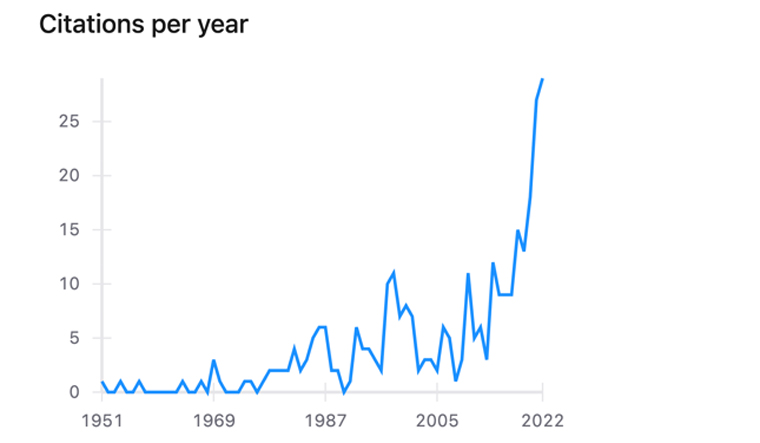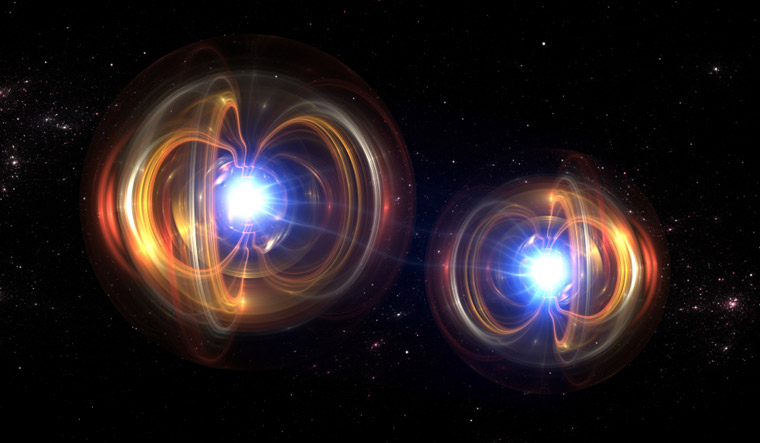Once, Albert Einstein famously bemoaned to a friend, "Do you really believe the moon is not there when you are not looking at it?" This is, of course, deeply contrary to our everyday experiences. Yet that question is being asked, answered, re-asked, re-answered even now. So much so that three physicists - John Clauser, Alain Aspect, and Anton Zeilinger - have won this year's Nobel Prize for Physics for seeking to answer it.
Quantum mechanics, in its pristine theoretical framework, has been around for more than a century. But the research into quantum mechanics is more active now than it was a hundred years ago. This is because many rather simple facts about quantum mechanics couldn't be proven until the 1980s through experiments. By about the year 2000, though, the field had been completely changed by experimental progress. It's changing faster than ever now.
There is something called quantum entanglement, which is the key ingredient behind the work of this year's Nobel winners. They performed measurements that Einstein didn't think were possible, and the understanding that we've gained from these experiments is crucial for quantum computing today.
 Alain Aspect, John F. Clauser and Anton Zeilinger | Image: Niklas Elmehed/Nobel Prize
Alain Aspect, John F. Clauser and Anton Zeilinger | Image: Niklas Elmehed/Nobel Prize
What is so important about this work? What did they prove and why was it considered worthy of a Nobel?
Before the advent of quantum mechanics, we thought that the world was deterministic—that is, if we knew enough information about the system beforehand, then in principle we could determine everything about the system in the future and in the past. In this regard, Einstein has famously quoted, "God does not play dice." This was very compelling. After all, Newton's equations of motion have worked incredibly well, so why shouldn't this principle not apply to everything? Unfortunately for determinists, we finally stumbled across quantum mechanics, and quantum mechanics does not play well for determinism. It is, by its nature, probabilistic, and mind you, highly accurate, by any given standards.
Albert Einstein is well-known for having doubts about quantum mechanics. He conjectured that quantum mechanics couldn't possibly explain everything about nature, and he said that it was missing something. In quantum mechanics, we can't tell how a measurement will turn out. We can only guess how likely it is that something will happen (probabilities). Without quantum mechanics, I could say that if we shoot a particle cannon, the particles will land at a certain place. With quantum mechanics, I can only say that they'll land at a certain place some percentage of the time and have a small chance of being everywhere else.
Let's say you have two electron spins which can either be in spin up or spin down. The entanglement of these two electrons produces an interesting state where if one of the electrons is measured to be in the spin-up state, then the other must be in the spin-down state. This is a result of the nature of quantum objects. Each electron can be described as a wave function (mathematical form of Alladin’s lamp), that is, a different wave function for each particle. When you measure a wave function, it collapses to a single state. So, by measuring, we destroy the wave function. When two particles are entangled, rather than being described by two wave functions, they are described by the same wave function. So, if you measure one of the electrons, the wave function collapses for both of the particles. Now here is the crux of the thought experiment. What would happen if you took two of these entangled particles and then separated them by a great distance? Let's say they were separated by several light seconds. In this state, if you could measure one of the electron states, say in spin up, then instantaneously the other electron would become spin down, which would appear to break the speed of light and therefore be forbidden (as the speed of light is a universal constant). Einstein called this collapse of the wave function "spooky action at a distance." He thought that there must be some "hidden variables" that the particles knew ahead of time about their state, so no information could travel faster than light.
In essence, he suggested that before the particles were separated, they decided which one would become spin up and which one would become spin down. This was all hinted upon in a 1935 study authored by Albert Einstein, Boris Podolsky, and Nathan Rosen (often referred to as the "EPR paper"). In this paper, they argue that quantum mechanics isn't enough to explain how nature works, so it can't be complete. They were the first to realize how important "entangled" particles are for understanding quantum mechanics. This would become very important and lead to technologies like quantum teleportation.
 Source: https://inspirehep.net/literature/42441
Source: https://inspirehep.net/literature/42441
Look at this graph, which shows how many times the paper has been cited over the years. There's not much going on until the middle of the 1960s. What then did the 1960s bring? That's when particle physicist John Bell got on the case. Bell worked at CERN. He started to wonder if a theory with hidden variables could always give the same results as quantum mechanics because of the EPR paper. Bell suggested that there was indeed a way to test if hidden variables were true or not. This test would come to be known as "Bell’s inequality." That was just math, though. Now, the question was: can one make a measurement in which Bell's inequality is broken and hidden variables are shown to be wrong? Or, will the measurements always fit with an explanation based on a hidden variable, which would rule out quantum mechanics?
Stuart Freedman and John F. Clauser at the University of California at Berkeley did the first experiment to find this out in 1972. They found that Bell's inequality had been broken, which proved that quantum theory was right. This result was a bit controversial for a while because it didn't have a huge impact on statistics and it left a few "loopholes" that could be used to make hidden variables fit with observations. For example, you wouldn't need "spooky action" to explain correlations in measurement results if one detector had time to affect the other detector. But by the late 1970s, physicists had learned how to make and find single photons, which are fundamental units of light. This made things much easier, and starting in the 1980s, a number of experiments, especially those by Alain Aspect and his group, closed the remaining gaps and improved the statistical significance. Most physicists agreed at that point that Einstein was wrong. Hidden variables can't work.
What all came out of this was the fact that quantum mechanics was not the only thing that was proven by these experiments. Physicists learned how useful entangled particles are by pushing the limits of their experiments. They're just something totally different from anything they'd dealt with before. And you can't only entangle two particles; you can entangle any number of them. And the more you mix them up, the stronger the quantum effects are. This has led to a lot of different uses, such as quantum cryptography. This is a way to send messages using quantum particles in a safe way. The information is safe because quantum particles have this weird property that if you measure just what their properties are, that changes them. Because of this, if you use quantum particles to encrypt a message, you can tell if someone else reads it. Entangled particles can also be used to make more accurate measurements. For example, they can be used to study materials or measure fields like gravity or magnetism. This is known as quantum metrology.
Quantum teleportation, however, might be the strangest thing that has come out of this. You can send quantum information with entangled states using quantum teleportation, even if you don't know what the quantum information is. A simplified and modernised version of this goes something like this: Pairs of particles are sent off in different directions from a common source, targeted for two observers, Alice and Bob, each stationed at opposite ends of the solar system. Quantum mechanics dictates that it is impossible to know the spin, a quantum property of individual particles, prior to measurement. When Alice measures one of her particles, she finds its spin to be either up or down. Her results are random, and yet, when she measures up, she instantly knows Bob’s corresponding particle must be down. At first glance, this is not so odd; perhaps the particles are like a pair of shoes—if Alice gets the right shoe, Bob must have the left. But under quantum mechanics, particles are not like shoes, and only when measured do they settle on a spin of up or down. Note that this was indeed the original EPR’s key conundrum.
In 1997, groups led by Sandu Popescu and Anton Zeilinger achieved the first successful quantum teleportation. They even do it in space now. I really mean it. Anton Zeilinger was part of a group that conducted a cosmic Bell test in 2017. The scientists used telescopes on the Canary Islands to make their random judgments about detector settings based on stars so far away in the sky that their light would not reach each other for hundreds of years. However, quantum mechanics still emerged victorious in the end.
One can look at the references to the EPR paper. They're now higher than they've ever been. Quantum technologies have a lot of potential that we're just starting to learn about. And that's not the only important thing about this research. It is also important because it pushes the limits of what we know. It's a way to learn about fundamentally new things in nature. Who knows if Einstein might have been right after all, and quantum mechanics might not be the last word. Research in quantum mechanics is moving so fast right now that it's hard to keep up. The quantum zoo is full of information, optics, computation, cryptography, simulations, metrology, etc. It has even brought back the big philosophical questions about how quantum mechanics actually works.
The second quantum revolution surely did deserve a Nobel Prize, and the winners, Anton Zeilinger, John F. Clauser, and Alain Aspect, have been the names most prominently linked to it. We will perhaps witness very soon if mother nature, what Einstein deemed as' God ', indeed plays a dice, or if she doesn't. Interesting times are all ahead of us.
(The author is a Postdoctoral Fellow at National Taiwan University in experimental Condensed Matter Physics)




